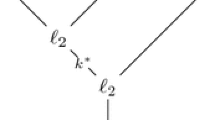Abstract
We answer a question of John Baez, on the relationship between the classical Euler characteristic and the Baez–Dolan homotopy cardinality, by constructing a unique additive common generalization after restriction to an odd prime p. This is achieved by \(\ell \)-adically extrapolating to height \(n=-1\) the sequence of Euler characteristics associated with the Morava K(n) cohomology theories for (any) \(\ell \mid p-1\). We compute this sequence explicitly in several cases and incorporate in the theory some folklore heuristic comparisons between the Euler characteristic and the homotopy cardinality involving summation of divergent series.
Similar content being viewed by others
Notes
A solution using a different technique was claimed in the preprint [4], but apparently it has a mistake. The proposed approach is however still interesting and merits further investigation.
By [15], for \(\pi \)-finite double loop-spaces, the K(n)-homology itself can not see the Postnikov invariants.
While \(\mathbb {Z}_p^n\) is not quite finitely generated, replacing it with \((\mathbb {Z}/p^N)^n\) for \(N\gg 0\) does not change the first (arbitrarily many) first terms of both sides of the equation, so we can still apply the formula to it.
References
Baez, J.: Euler characteristic versus homotopy cardinality. Lecture at “Fields Institute Program on Homotopy Theory and its Applications” (2003). https://math.ucr.edu/home/baez/cardinality/
Baez, J.: The mysteries of counting: Euler characteristic versus homotopy cardinality. Public Lecture at ”Categories in Algebra, Geometry and Mathematical Physics”, pp. 11–16 (2005). https://math.ucr.edu/home/baez/counting/
Baez, J.C., Dolan, J.: From finite sets to Feynman diagrams. In: Mathematics Unlimited—2001 and Beyond, pp. 29–50. Springer (2001)
Berman, J.D.: Euler characteristic and homotopy cardinality. arXiv preprint arXiv:1811.07437 (2018)
Bolker, E.D., Gleason, A.M.: Counting permutations. J. Combin. Theory Ser. A 29(2), 236–242 (1980)
Brown, K.S.: Cohomology of Groups, vol. 87. Springer, Berlin (2012)
Carmeli, S., Schlank, T.M., Yanovski, L.: Ambidexterity and height. Adv. Math. 385, 107763 (2021)
Carmeli, S., Schlank, T.M., Yanovski, L.: Ambidexterity in chromatic homotopy theory. Invent. Math. 228(3), 1145–1254 (2022)
Devalapurkar, S., Haine, P.: On the James and Hilton–Milnor splittings, and the metastable EHP sequence. Doc. Math. 26, 1423–1464 (2021)
Formichella, S., Straub, A.: Gaussian binomial coefficients with negative arguments. Ann. Comb. 23(3), 725–748 (2019)
Gessel, I.M.: Enumerative combinatorics, Volume 2 by Richard P. Stanley. Bull. Am. Math. Soc. 39(1), 129–136 (2002)
Gruber, B.: Alternative formulae for the number of sublattices. Acta Crystallogr. A 53(6), 807–808 (1997)
Hopkins, M., Kuhn, N., Ravenel, D.: Generalized group characters and complex oriented cohomology theories. J. Am. Math. Soc. 13(3), 553–594 (2000)
Hopkins, M., Lurie, J.: Ambidexterity in \(K(n)\)-local stable homotopy theory, preprint (2013)
Hopkins, M.J., Ravenel, D.C., Wilson, W.S.: Morava Hopf algebras and spaces \(K(n)\) equivalent to finite Postnikov systems. Stable Unstable Homotopy 19, 137–163 (1998)
Kuhn, N.J.: The morava K-theories of some classifying spaces. Trans. Am. Math. Soc. 304(1), 193–205 (1987)
Kuhn, N.J.: Character rings in algebraic topology. Lond. Math. Soc. Lect. Notes 139, 111–126 (1989)
Leinster, T.: The Euler characteristic of a category. Doc. Math. 13, 21–49 (2008)
Lewis, J.B., Liu, R.I., Morales, A.H., Panova, G., Sam, S.V., Zhang, Y.X.: Matrices with restricted entries and \(q\)-analogues of permutations. arXiv preprint arXiv:1011.4539 (2010)
Lurie, J.: Higher Algebra. http://www.math.harvard.edu/~lurie/
Lurie, J.: Elliptic Cohomology III: Tempered Cohomology. https://www.math.ias.edu/~lurie/papers/Elliptic-III-Tempered.pdf (2019)
Mahler, K.: An interpolation series for continuous functions of a \(p\)-adic variable (1958)
Mutlu, A., Porter, T.: Iterated Peiffer pairings in the Moore complex of a simplicial group. Appl. Categ. Struct. 9(2), 111–130 (2001)
Ponto, K., Shulman, M.: The linearity of traces in monoidal categories and bicategories. arXiv preprint arXiv:1406.7854 (2014)
Prasma, M., Schlank, T.M.: Sylow theorems for \(\infty \)-groups. Topol. Its Appl. 222, 121–138 (2017)
Ravenel, D.C., Wilson, W.S.: The Morava \(K\)-theories of Eilenberg–MacLane spaces and the Conner–Floyd conjecture. Am. J. Math. 102(4), 691–748 (1980)
Tamanoi, H.: Generalized orbifold Euler characteristic of symmetric products and equivariant Morava \(K\)-theory. Algebr. Geom. Topol. 1(1), 115–141 (2001)
Acknowledgements
Most of the results presented here were obtained during my first Ph.D. project back in 2017 under the supervision of Tomer Schlank (who was the one to suggest to “somehow use Morava K-theories”). they were subsequently announced in the traschromatic homotopy theory conference held in Regensburg that year and presented in several talks since then, but various distractions delayed the writing process. It should be noted that at the time, Lurie’s [21] was not published yet and much of the general higher semiadditive context was still missing as well. Thus, in a sense, the present time is more ripe for communicating these ideas, which may partially excuse the long delay. I am deeply grateful to Tomer Schlank for his help with this project, as well as his mentoring over the passing years. I also thank him for useful comments on an earlier draft of this paper. I wish to extend my gratitude also to Maxime Ramzi for reviving my interest in this project through many stimulating conversations motivating me to finally write this paper. I would also like to thank John Baez for his numerous excellent expositions of these and other higher categorical ideas, that got me into thinking about this project in the first place. I would like to thank all the present and former members of the seminarak group for stimulating conversations and encouragement, with special thanks to Shai Keidar and Shaul Ragimov for providing the elegant argument in the proof of the second part of Proposition 3.5. Finally, I would like to that the anonymous referee for several useful comments.
Author information
Authors and Affiliations
Corresponding author
Additional information
Publisher's Note
Springer Nature remains neutral with regard to jurisdictional claims in published maps and institutional affiliations.
Rights and permissions
Springer Nature or its licensor (e.g. a society or other partner) holds exclusive rights to this article under a publishing agreement with the author(s) or other rightsholder(s); author self-archiving of the accepted manuscript version of this article is solely governed by the terms of such publishing agreement and applicable law.
About this article
Cite this article
Yanovski, L. Homotopy cardinality via extrapolation of Morava–Euler characteristics. Sel. Math. New Ser. 29, 81 (2023). https://doi.org/10.1007/s00029-023-00886-3
Accepted:
Published:
DOI: https://doi.org/10.1007/s00029-023-00886-3



